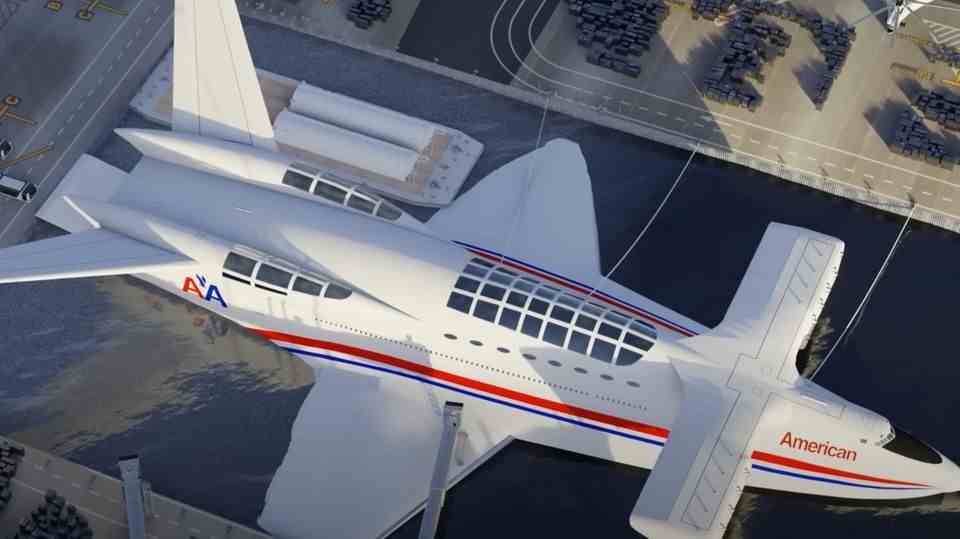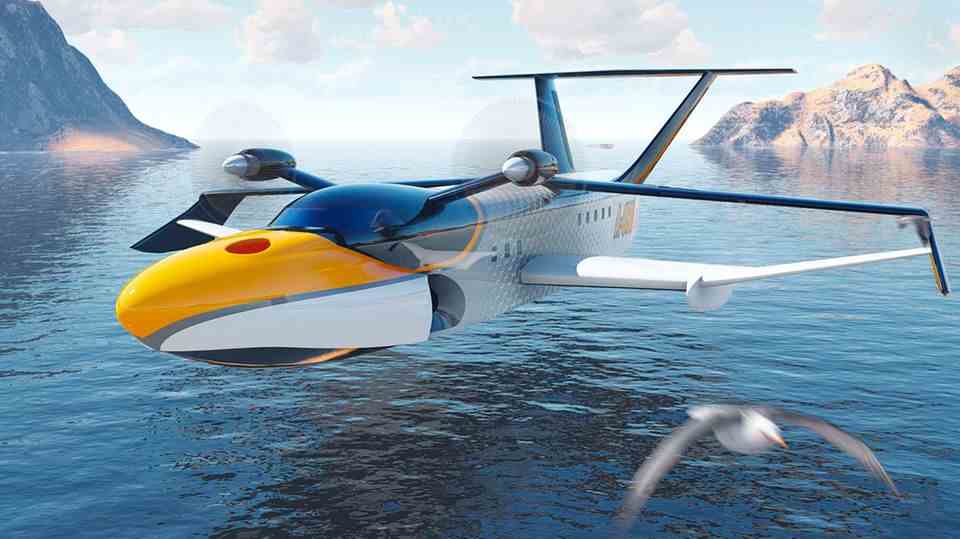Pentagon plan
The Aerocon Wingship – the largest aircraft ever to be built
The Aerocon wingship could only have glided near the surface.
© 3D model by Tim Samedov
At the end of the Cold War, the Pentagon planned an ekranoplan that could have transported an entire battle group across the seas at 750 km/h. Had it been built, it would have revolutionized civil aviation as well.
At the end of the Cold War, the Pentagon wanted to build a massive Ekranoplan, larger even than the USSR’s “Caspian Sea Monster”. The Soviet ekranoplanes were designed as “Fleet Destroyers”. They flew over the waves at almost 500 km/h and carried a battery of anti-ship missiles. (The “duck” and the “monster” were supposed to smash Nato’s fleets)
DARPA (Defense Advanced Research Projects), on the other hand, wanted to build some kind of flying transport ship. As big as a hotel, it would have been rushed across the seas at 750 km/h. His job was that of a landing ship. The Aerocon Wingship was intended to transport troops, tanks and helicopters. The vehicle’s capacity was to include 32 helicopters, 20 tanks, four landing craft and about 2000 soldiers.
Since ekranoplanes require much less fuel than airplanes, the Aerocon Wingship would probably have turned civil aviation upside down if it had been built. The monster would have weighed 400 tons, was 172 meters long and could have transported a payload of 1500 tons. That’s about 30 times as much as a Boeing 747. The range would have been almost 20,000 kilometers, which can be translated as “worldwide”.
Riding on an air roller
What does ground effect do: An ekranoplan works similarly to a hovercraft, only much more elegantly. Its wide, stubby wings are shaped in such a way that a kind of air roll forms between them and the surface. The ekranoplan then “rides” on the buoyancy of its own wave. However, this only works over the sea and undeveloped areas; such a jet cannot fly over populated areas. A critical phase is also the landing, the moment when the wave collapses. The concept for the military had only one clear disadvantage, the Aerocon Wingship could only have been used over water, over seas and large rivers. It was not a device that could have transitioned from ground effect gliding to real flight.
Steven Hooker, the plane’s chief designer, was obsessed with the idea. It is in the nature of ground effect that such an ekranoplan becomes more and more tempting the bigger it gets (Russia wants to build the world’s largest cargo plane). The payload increases disproportionately with the size. The US military considered buying 13 devices for a whopping $15 billion. But with the end of the Cold War, the plans were dropped.
Renaissance of the small gliders
Again and again there are institutions in Russia to build a large Ekranoplan as a transporter, they were never mass-produced. The USA is also currently developing such a model for the military. Whether it will be built is questionable. But in the civil sector, the ekranoplane is experiencing a renaissance. As a water taxi or as a super ferry. Because it doesn’t actually fly, such a vehicle is not subject to aviation regulations. In addition, it only requires a jetty and no airfield. Compared to ships, it can move sensationally fast. In addition, an ekranoplan consumes much less energy than a flying airplane, so that battery operation is also possible here.
These small ekranoplanes are all based on the basic designs of Dr. Alexander Lippisch. He developed the reverse swept wing design in the 1960s. Lippisch is considered a brilliant designer. Among other things, Hitler’s Messerschmitt Me 163 “Komet” missile interceptor was based on his designs.
Also read:
Russia wants to build the world’s largest cargo plane
The “duck” and the “monster” were supposed to smash Nato’s fleets
This air-to-water taxi is based on the design of Hitler’s rocket builders




